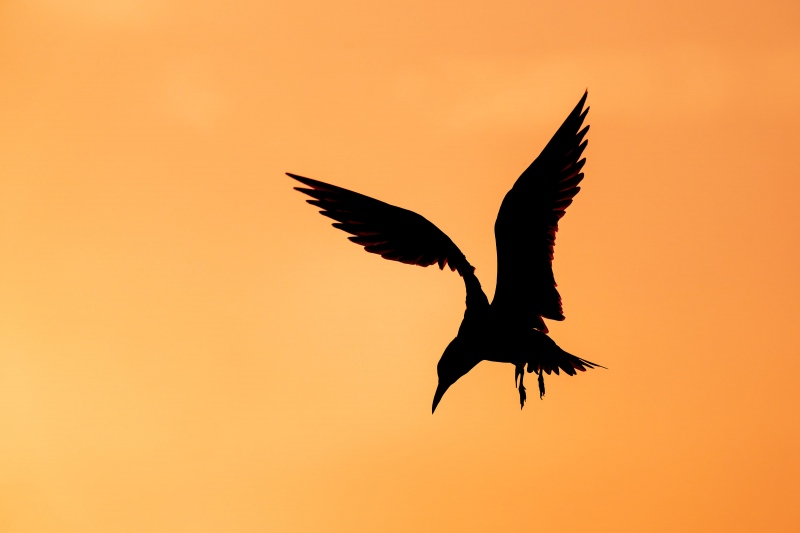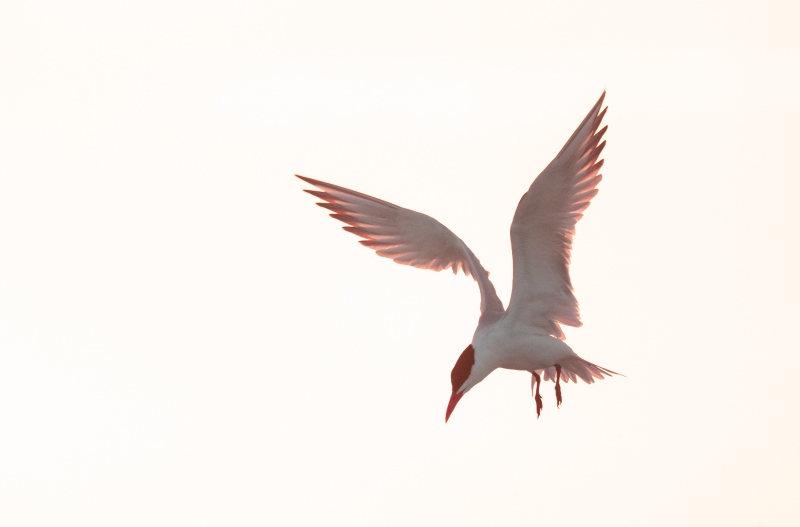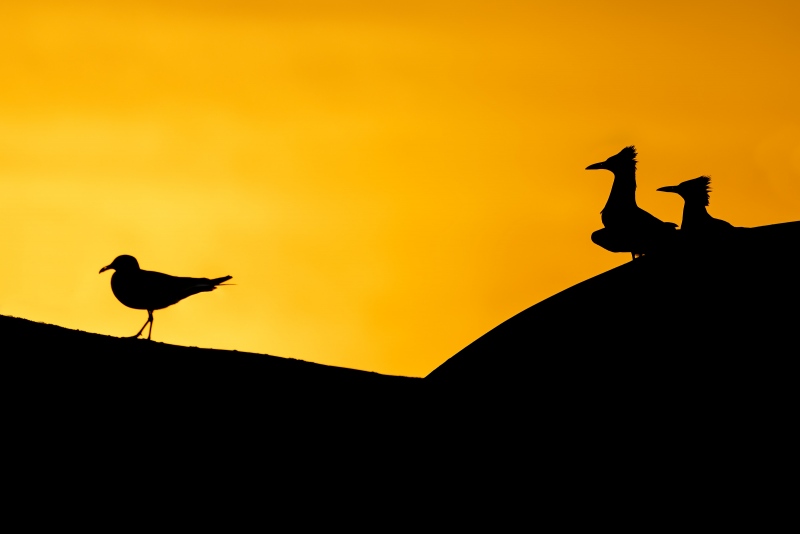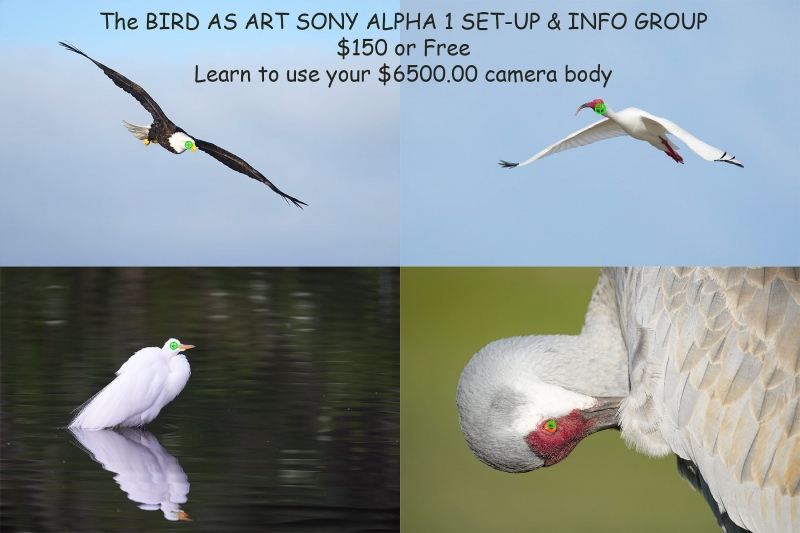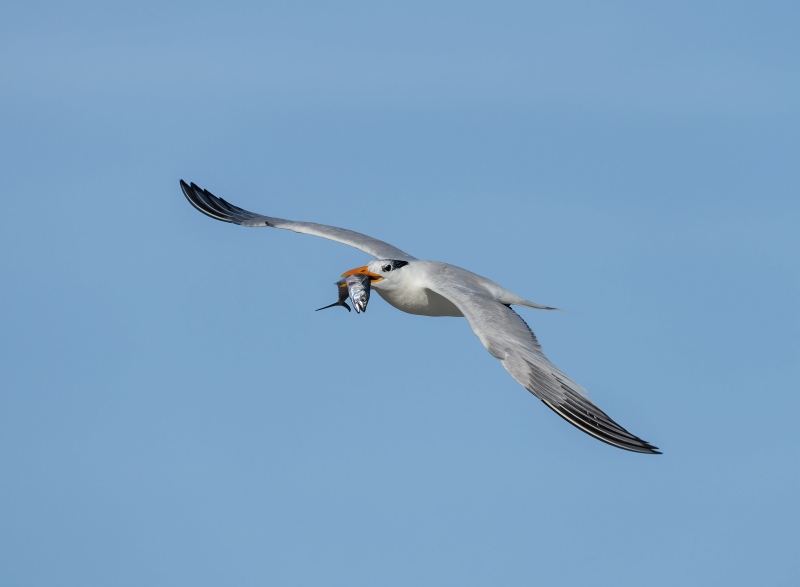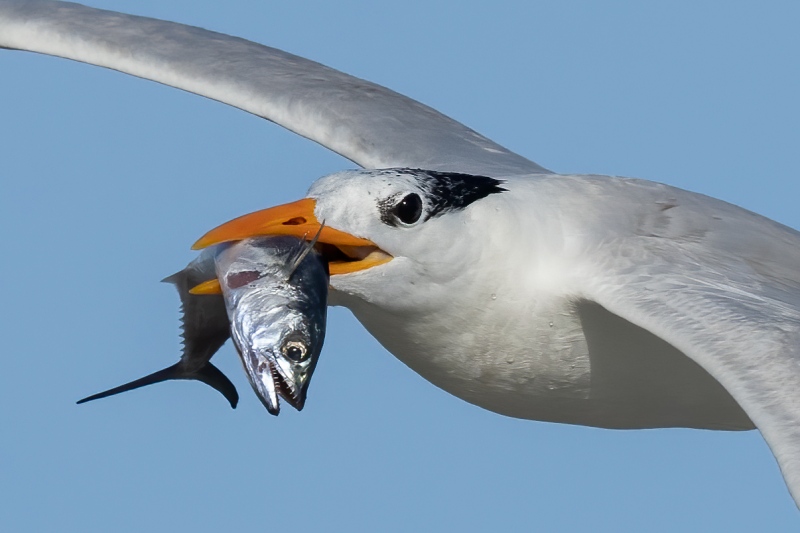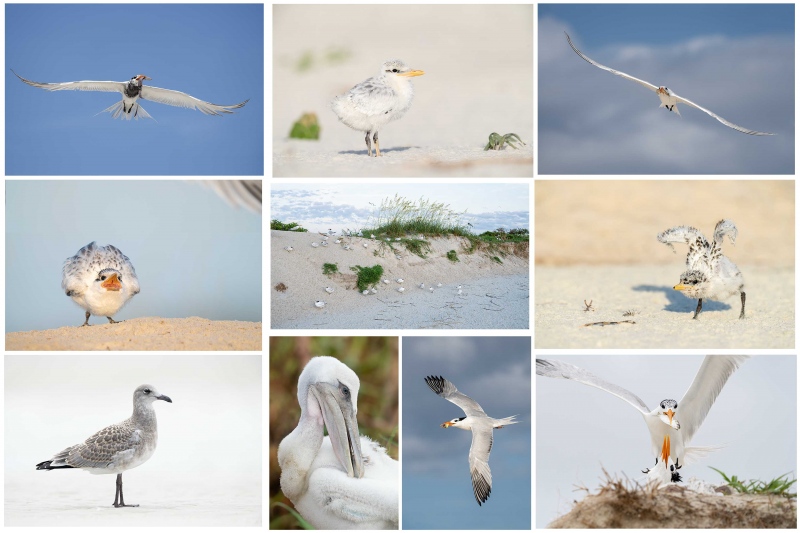What’s Up?
The IPT group enjoyed a lovely orange-glow sunrise on Monday morning and created many fine slow shutter speed tidal pool-scapes. As the tide was dropping, I concentrated on the flocks of skimmers and other birds landing and blasting off from the color on the edge of the surf. I made one huge mistake when trying to create pleasing blurs: rather than relying on AF to track the birds, I relied on manual focus with focus peaking. Never again … I created more than one hundred images at 1/8, 1/15, and 1/30 second. I deleted every single one. Lesson learned: focus peaking is excellent for landscapes and pleasing blurs of the same, but with flocks of birds, the closest bird needs to be in sharp focus. And only AF can deliver that consistently.
We had a long and fruitful laptop learning session at the Marshside Grill in Brunswick, GA, and followed that up with another in our Villas by the Sea unit — Erik Bowles has continued to be a great help to me! That done, we headed out for sunset. At the Jekyll Fishing Pier we had a Great Blue Heron in a creek. On the pier itself, I headed out to the end in search of silhouettes. Eric stayed near the base of the pier with the rest of the group. Curious as to what they were doing, I moseyed over and made some of the very best images of the trip — Royal Terns braking to land on the roof of a shelter with a tangerine-orange sky background. Thank you Eric!
Today is is Tuesday 12 April 2022. The forecast is for cloudy early followed by death of sun and clear skies. I am treating the group to an Okefenokee Boat tour. We will have lunch in Darien, the oldest town in Georgia, and then visit Harris Neck NWR. I drive home on Wednesday morning. Wherever you are and whatever you are doing, I hope that you too have a great day. This blog post took about an hour to prepare and makes thirty-two days in a row with a new one.
Please remember to use the B&H and Amazon links that are found on most blog pages and to use the BIRDSASART discount code at checkout when purchasing your new gear from Bedfords. Please, also, consider joining a BAA IPT. You will be amazed at how much you will learn!
Nikon D5 Professional dSLR
BIRDS AS ART Record Low Price
Sigmon Whitener is offering a Nikon D5 (Dual XQD/CF Express Type B) in like-new condition with 55,000 actuations for a BAA record-low $2796.95. The sale includes the original box and everything that came in it including the strap, one battery, the dual battery charger, the manual (Sp and En), the USB connecting cord, and insured ground shipping via major courier to lower-48 US addresses only. Although the D5 has a 20MP sensor, the frame rate and AF tracking are the best (IMO) you can get in a DSLR. Some of my best BIF shots were made with this camera. It’s also great for any type of sports photography. And the low light performance is best of any camera I have owned. Your item will not ship until your check clears unless other arrangements are made.
Please contact Sigmon via e-mail or by phone at 1-818-239-2403 (Pacific time).
The D5 was my first Nikon camera body. After using it for ten minutes on flying pelicans in San Diego I sold all my Canon gear. The AF system is indeed superb. artie
Nikkor AF-S 80-400mm f4.5-5.6G ED VR Lens
BIRDS AS ART Record Low Price
Sold first day of being re-listed.
Sigmon Whitener is offering a Nikkor AF-S 80-400mm f4.5-5.6G ED VR lens in like new condition for a BAA record-low $1096.95. The sale includes the lens, all accessories that came with the original purchase – case, front and rear lens caps, manual, original Nikon lens collar and foot, lens hood, original box. Also included is a Really Right Stuff LC_A13 lens collar with RRS LCF-10B quick release foot. This collar makes for a much more robust and smoother action and sells new for about $250. I do not want to sell without the RRS collar and foot. and insured ground shipping via major courier to lower-48 US addresses only. Your item will not ship until your check clears unless other arrangements are made.
Please contact Sigmon via e-mail or by phone at 1-818-239-2403 (Pacific time).
I owned and loved this super-sharp and very versatile lens when I shot Nikon. It was my go-to lens on my bucket-list Emperor Penguin trip to Snow Hill Island, Antarctica. It complements either the 500 PF or the 600 f/4 VR lenses perfectly. As it sells new for $2,296.95, you can save an incredible $1200.00 on Sigmon’s pretty much new lens. artie
|
|
|
This image was also created on 7 July 2021 at Huguenot Memorial Park in Jacksonville, FL. I used the hand held Sony FE 200-600mm f/5.6-6.3 G OSS lens (at 500mm) and The One, the Sony Alpha 1 Mirrorless digital camera. ) The exposure was determined using Zebra technology with ISO on the Thumb Dial. ISO 640: 1/3200 second at f/7.1 (stopped down 1/3 stop) in Manual Mode. AWB at 6:36:22am on a clear afternoon. RawDigger showed the exposure to be dead-solid perfect.
Tracking: Zone AF-C with Bird Face/Eye Detection performed perfectly. Be sure to click on the image to enjoy a high-res version.
Image #1: Royal Tern with Spanish Mackerel for young
|
Baitfishes and More
One of the funnest things about photographing the tern colony at Jacksonville after the chicks have hatched is the great variety of prey items that they bring in for the young: all manner of immature fish and baitfish, squid, huge shrimp, tiny crabs, and even sand crabs (AKA sand bugs, sand fleas, or mole crabs). The flight photography is non-stop with both the big super-telephoto lenses (tripod-mounted or hand held) and the hand held intermediate telephotos, especially the Sony 200-600, the Canon 100-500, and the Nikon 200-500.
|
|
Image #1A: 100% crop of the Royal Tern with Spanish Mackerel for young image
|
What More Can I Say About the Sony A1?
Apologies if I am sounding like a broken record: Sony Zebra technology for stills allows the competent user to create perfect exposures consistently and the AF system and image quality of the Sony 1 are unmatched by any mirrorless camera body. That said, dSLRs are on the way out. The world ahead is mirrorless. All the above is true only If you are photographing birds in flight and/or animals in action. If you are photographing flowers and scenics and static birds and/or animals there is no need for you to abandon your dSLRs to switch to mirrorless.
Picking Your Keepers
I had kept seven razor-sharp images of this bird in flight with the baby mackerel. I selected Image #1 as the best to be processed for the blog because of the separation of the tail from the bottom jaw of the fish. In the other six (very nice =) images the tail merged with the bottom jaw.
|
|
|
Click on the image to better see the green eye-AF boxes in action.
Sony Alpha 1 Flight Photography AF Points!
|
The SONY Alpha a1 Set-up Guide and Info Group: $150.00 (or Free)
The SONY Alpha a1 Set-up Guide and Info Group is going great guns as more and more folks chime in with thoughtful questions and experience-based answers. As the a1 is becoming more readily available, more and more folks are getting their hands on this amazing body. By early April, the group was up to an astounding 113 lucky and blessed folks. Early on, we discussed the myriad AF options. I gave my opinion as to the best one for flight and general bird photography. The best news is that everyone in the group receives an e-mail that includes a .DAT file with my a1 settings on it, and explicit directions on how to load my settings onto your a1; talk about convenience! I am now offering a .DAT file compatible with firmware update 1.20. Your entry into the group includes a consolidated Sony a1 CAMSETA2 INFO & GUIDE. New a1 folks will now receive three e-mails instead of the previous 28! You will see new e-mails as they are published. Simply put, this e-mail guide is an incredible resource for anyone with an a1.
All who purchased their Alpha 1 bodies via a BAA affiliate link — B&H or Bedfords — will receive a free Sony Alpha a1 Set-Up Guide and free entry into the Info Updates group after shooting me their receipts via e-mail. (Note: it may take me several days to confirm B&H orders.). Others can purchase their guide here in the BAA Online Store.
|
|
|
Click on the composite image to enjoy the incredible quality of the hi-res JPEG.
Clockwise from upper left clockwise and back around to the center: Royal Tern in flight with squid for chick; Royal Tern chick on beach; Royal Tern in flight with shrimp for young; Royal Tern chick — double overhead wing stretch; Royal Tern landing with greenback for chick; Royal Tern in flight with juvenile mahi mahi for chick; Brown Pelican — large chick preening; Laughing Gull in fresh juvenal plumage; Royal Tern chick begging; Many Royal Terns with many chicks on face of dune.
|
Jacksonville IPT: #1: 4 FULL DAYS — the afternoon of 16 June thru the morning of MON 20 June 2022: $2,099.00. (Limit 6 photographers)
Jacksonville IPT #2: the afternoon of FRI 1 JULY thru the morning of TUES 5 July 2022: $2099.00 (Limit 6 photographers)
Jacksonville IPT #3: the afternoon of FRI 15 JULY thru the morning of TUES 19 July 2022: $2099.00 (Limit 6 photographers)
Ride with me: add $200.00. I do not like to disappoint: each trip will run with one participant. If necessary.
I first visited the breeding bird colony at Jacksonville in late June 2021. I was astounded. There were many thousands of pairs of Royal Terns nesting along with about 10,000 pairs of Laughing Gulls. In addition to the royals, there were some Sandwich Terns nesting. And there are several dozen pairs of Brown Pelicans nesting on the ground. Flight photography was non-stop astounding. And photographing the tern chicks was relatively easy. Folks could do the whole trip with the Sony 200-600, the Canon 100-500 RF, or the Nikon 500 PF or 200-500 VR. With a TC in your pocket for use on sunny days. Most of the action is within 100 yards of where we park (on the beach). As with all bird photography, there are times when a super-telephoto lens with either TC is the best tool for the job.
Morning sessions will average about three hours, afternoon sessions about 1 1/2 hours. On cloudy mornings with favorable winds, we may opt to stay out for one long session and skip the afternoon, especially when the afternoon forecast is poor. Lunch is included on the first three days of the IPT and will be served at my AirBnB. After the first lunch there will be an introductory program. On days two and three we will do image review and Photoshop after lunch.
We will be based somewhere west and a bit north of Jacksonville where there are many AirBnB possibilities. The deposit is $599.00. Call Jim at the office any weekday at 863-692-0906 to pay by credit card. Balances must be paid by check.
What You Will Learn on a Jacksonville IPT
- 1- First and foremast you will learn to become a better flight photographer. Much better.
- 2-You will learn the basics and fine points of digital exposure. Nikon and Canon folks will learn to get the right exposure every time after making a single test exposure, and SONY folks will learn to use Zebras so that they can be sure of making excellent exposures before pressing the shutter button.
- 3- You will learn to work in Manual exposure mode even if you fear it.
- 4- You will learn to evaluate wind and sky conditions and understand how they affect bird photography, especially the photography of birds in flight.
- 5- You will learn several pro secrets (for each system) that will help you to become a better flight photographer.
- 6- You will learn to zoom out in advance (because the birds are so close!) 🙂
- 7- You will learn how to approach free and wild birds without disturbing them.
- 8- You will learn to spot the good and the great situations.
- 9- You will learn to understand and predict bird behavior.
- 10- You will learn to design pleasing images by mastering your camera’s AF system.
- 11- You will learn to choose the best perspective.
- 12- You will learn to see and control your backgrounds.
- 13- You will learn to see and understand the light.
- 14- You will learn to see and create pleasing blurs in pre-dawn situations.
- 15- You will learn to be always ready for the most likely event.
And the best news is that you will be able to take everything you learn home with you so that you will be a better photographer wherever you are and whenever you photograph.
Typos
With all blog posts, feel free to e-mail or to leave a comment regarding any typos or errors.

